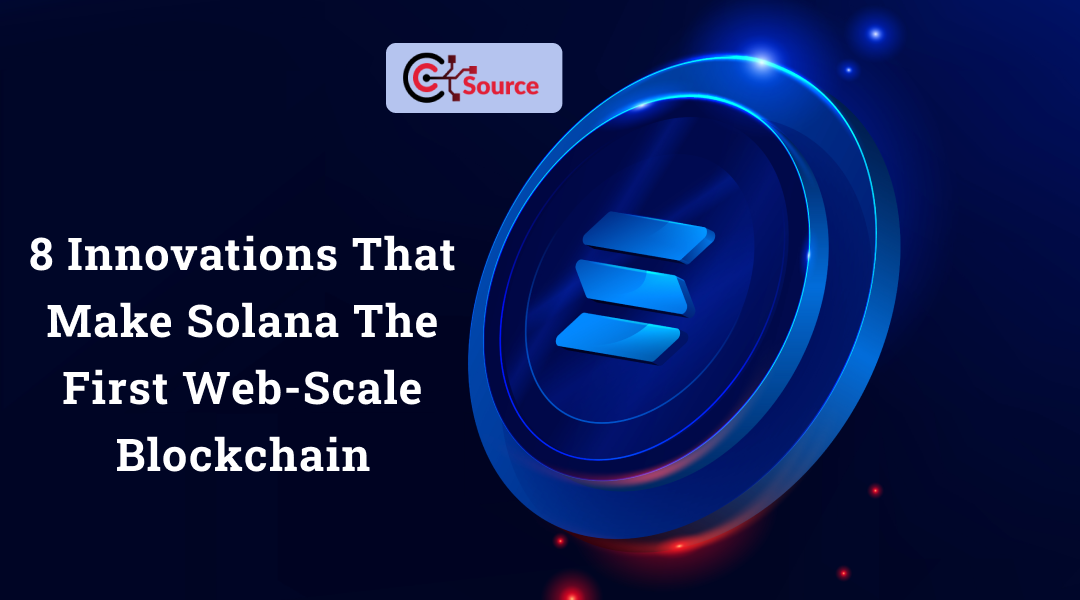Solana is a web-scale blockchain that enables decentralized apps and markets to run quickly and securely. The Solana-based blockchain supports up to 50,000 TPS (Transactions Per Second) and 400ms Block Times. The Solana software’s ultimate goal is to demonstrate that there is a viable set of algorithms that can be combined to form a blockchain.
As a result, transaction throughput would increase according to network capacity, achieving all of the properties of a blockchain, including scalability, security, and decentralization. More evidently, the system will be able to support an upper band of 710, 000 TPS on a standard gigabit network and 28.4 million TPS on a 40-gigabit network.
For developing a decentralized and permissionless network that aligns with the performance of a single node, Solana developed 8 key technologies:
- Proof of History (POH) – a clock before consensus
- Tower BFT – a PoH optimized version of PBFT
- Turbine – a block propagation protocol
- Gulf Stream – Memepool-less transaction forwarding protocol
- Sealevel – Parallel smart contracts run time
- Pipelining – a Transaction processing unit for validation optimization
- Cloudbreak – Horizontally-scaled accounts database and
- Archivers – Distributed ledger storage
- Proof of History
Proof of History (POH), a globally available, permissionless source of time on the network that works before consensus, is the key Solana innovation. POH is not an anti-Sybil mechanism or a consensus procedure. POH, on the other hand, is a solution to the clock problem.
Unlike other blockchains, which require validators to communicate with one another in order to agree that time has passed, each Solana validator keeps track of time by encoding it in a simple SHA-256, sequential hashing verifiable delay function (VDF). For unpredictability, Solana does not employ a VDF. Instead, each validator keeps its own clock using the VDF. Leader selection is planned ahead of time for an entire era because each validator has its own clock.
- Tower BFT
Solana runs Tower Consensus on top of Proof of History, a PBFT-like consensus algorithm that takes advantage of the synchronized clock. Tower Consensus, unlike TBFT, values liveliness over uniformity. Nodes, like PBFT, increase the timeouts of all other validators in the network exponentially.
- Turbine
Solana can optimize how blocks are transported through the network independently of consensus as long as the consensus layer does not rely on peer-to-peer messaging. Solana’s block-propagation mechanism, Turbine, is significantly influenced by BitTorrent. When a block is streamed, it is split into small packets with erasure codes and then dispersed among a large number of random peers.
The fanout mechanism must be fault-resistant. As a result, validators use Reed-Solomon erasure codes to encrypt data and provide fault tolerance.
- Gulf Stream
Memepool management is a new type of challenge in a high-performance network that other chains don’t have to deal with. Gulf Streamworks by bringing transaction caching and forwarding to the network’s edge. Clients and validators forward transactions to the expected leader ahead of time since every validator knows the order of forthcoming leaders in the Solana architecture. Validators can now perform transactions ahead of time. Reduce confirmation times, replace leaders more quickly, and relieve memory load on validators by removing unconfirmed transactions from the transaction pool.
- Sealevel
Solana developed Sealevel, a hyper-parallelized transaction processing engine that scales horizontally over GPUs and SSDs, to take advantage of the company’s high-performance network. The rest of the blockchains are single-threaded machines. Solana is the only chain that allows for the execution of multiple transactions in a single shard.
- Pipelining
On the Solana network, the transaction validation procedure makes considerable use of pipelining, a CPU-design improvement. When a stream of input data needs to be processed in a series of steps, and each step requires distinct hardware, pipelining is the right procedure to use.
- Cloudbreak
Cloudbreak, a state architecture optimized for concurrent reads and writes dispersed across a RAID 0 configuration of SSDs, was created for Solana. Each additional disc improves the amount of storage available to on-chain programs as well as the number of concurrent reads and writes that they can do while running.
- Archivers
On Solana, data storage is delegated from validators to Archivers, a network of nodes. Archivers do not take part in consensus. The state’s past is fragmented and erasure-coded in numerous ways. Small sections of the state are stored by archivers. The Archivers will be asked to confirm that they are storing the data that they are required to on a regular basis by the network. Solana makes use of Proofs of Replication (PoRep), which are largely influenced by Filecoin.
Conclusion
The Solana network is a lightning-fast distributed ledger system that will always keep going as a result of these eight fundamental inventions. Consensus does not slow it down. Furthermore, the system optimizes data propagation, makes extensive use of parallel GPUs for transaction processing, and does not burden validators with a large chain history.

